
Newham’s participants spent almost a year exploring the role of physical development and physicality (which we have also called ‘bodyfulness’) in young children. The objective was to develop a movement-rich culture in each setting, and to support parents to do the same at home, so that every child was able to achieve three hours of physical activity every day – as recommended by the British Heart Foundation.
Over several months, participants audited their outdoor provision, planned and implemented modifications to the management and resourcing of outdoors, and reflected on the changes to consolidate and sustain their new ‘movement curriculum’.
Action research is the crucial success factor: taking time to reflect on practice; testing ideas and resources; evaluating new approaches; and amending actions as appropriate.
LESSONS LEARNT
The culture of movement needs to be shared across the whole setting; change won’t be sustainable unless staff, parents and children appreciate the importance and delight of movement. Embarking on an action research project requires buy-in from all colleagues, particularly at critical launch points such as developing a shared understanding of physicality and the need for a risk-embracing approach to outdoor play.
Money is not the most important factor in enabling exciting, risky, active outdoor play. The project settings had little or no funding to make significant changes, so they explored interventions that centred on making the most of existing outdoor equipment and features.
Parents are fundamental partners in any drive to improve children’s levels of activity. Engaging them was achieved by sharing their child’s progress, inviting them to outdoor play sessions at the setting or in a local park and providing clear, accessible information about why movement is important.
There is more to physicality than the ability to run, balance or jump; children need to understand what their body can do and be encouraged to push themselves, take risks and delight in movement. Compelling (and unlikely) resources and exciting outdoor spaces play a part in this, but the crucial element is the knowledgeable and enthusiastic adults supporting movement play.
CASE STUDIES
Gainsborough Primary School
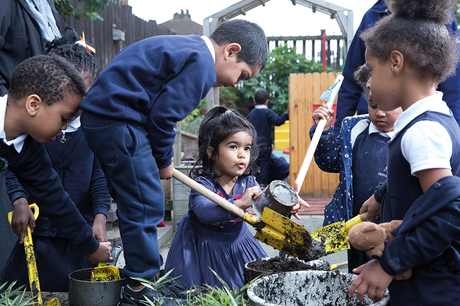
Nursery teacher Tess Hedoun joined the Outdoors and Active programme to invigorate the children and the outdoor space at Gainsborough Primary School. While blessed with plenty of outdoor space, and bright, modern classrooms with direct access to outdoors, the cluttered and inconsistent layout of the playground was inhibiting free movement. Opportunities to take physical risks were limited and, though there was plenty of storage, it wasn’t easily accessible, preventing children from taking responsibility for choosing and managing resources.
Tess’s initial audit revealed three key issues to work on:
- Exploiting the large climbing structure, seen by children and staff alike as dull.
- Increasing the length of time children were spending outdoors.
- Convincing parents of the importance of physical active play and risk-taking outdoors.
Gainsborough’s action research centred on increasing the physicality of less active children, their resilience and confidence in risk-taking. Communication was also a focus, and Ms Hedoun aimed to create a space that was so compelling, children couldn’t resist playing in it.
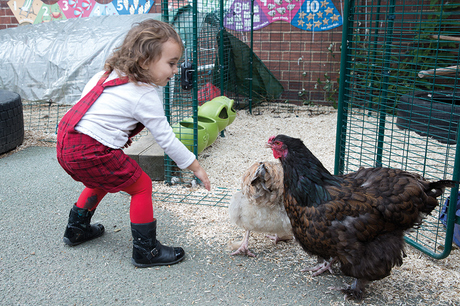
The nursery team observed that the afternoon-session children in particular often came to nursery tired, stationary or quiet and needed to be coaxed outdoors. Ms Hedoun and I studied the layout and fixtures of the three main areas that nursery children can access: a long Tarmac area with a climbing structure, a covered ‘verandah’ and a courtyard-style space, with shrubs, a raised bed and chicken coop. Having decided on an action research query that focused on the less active children, we agreed on a shortlist of interventions:
To entice reluctant children and give them ‘permission’ to take risks, staff were encouraged to accept a culture of embracing challenging and exciting play through informative staff meetings and by modelling the Risk Benefit approach to play. As a result, the children began to use the climbing structures in more inventive and exciting ways, with den-building materials regularly transforming them into themed play scenarios.
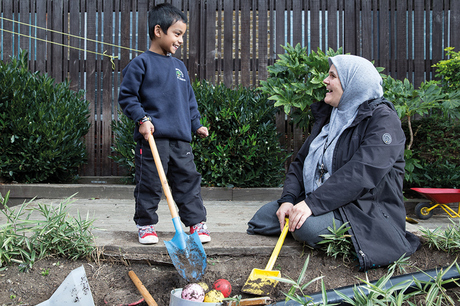
A raised-bed garden area was fenced off and underused, despite containing a tiny pond area which fascinated the children. After some debate, the pond was removed and the space redesigned into a generously large mud kitchen and digging area. This has proved hugely popular with many children, and its substantial size and plethora of digging, pouring and measuring resources means that they can now play together.
Storage facilities, including a shed, were relocated, which persuaded reluctant movers to get active outdoors and enabled children with a transportation schema to carry resources around the whole area. Storage under the verandah canopy was also rationalised, becoming accessible, organised and abundant, enabling children to shape their play options.
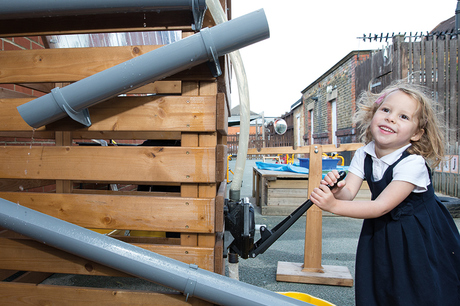
During the evaluation period, Ms Hedoun and a colleague noted that communication and confidence had risen in children who were previously less keen to be physically active outdoors. Tess’s research demonstrated that simple, inexpensive changes to the layout and management of a space can increase physicality, confidence and risk-taking. Ms Hedoun and colleagues have now begun their next step: advancing the physicality conversation with parents so that children maintain their new active lifestyles beyond the school day.
Little Diamonds Pre-School
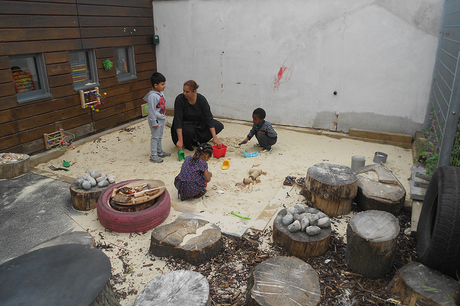
Little Diamonds Pre-school in Forest Gate has limited outdoor space and, while it is not a pack-away setting, its garden is very visible, meaning much of its equipment does have to be stored overnight. The setting has expanded rapidly, being in a priority area for the new two-year-olds’ provision. Manager Karrien Stevens is determined to provide the best possible movement opportunities for the children.
At the start of the Outdoors and Active programme, I carried out an advisory visit to each of the participating settings, to help them prioritise and focus on interventions that would be most likely to have a quick impact; Ms Stevens and I agreed we needed to be more generous with the range and quantity of resources. A lack of natural resources, a cramped arrangement of features and a huge tree were preventing children from making the big, energetic movements they needed.
At a staff meeting, colleagues agreed a detailed position statement for outdoor play, which began: ‘Our staff team is committed to creating a culture that will harness and increase children’s physicality and activity levels rather than restrict them. We offer long periods of time to each and every child to access and use outdoors to its full potential.’
The Outdoors and Active audit tools (see the first of these articles for more information) enabled Ms Stevens and her team to identify gaps in provision and devise interventions to test. The setting’s own progress tracker tool was also employed to measure the success (or otherwise) of these interventions and, guided by their position statement, they agreed to:
- reorganise outdoors to provide more space to move freely in
- resource areas generously, and with an abundance of natural materials
- get out and about beyond the setting more frequently, in particular making use of the communal grassy area beyond the setting’s boundary fence
- be pro-active in sharing children’s physicality with family members.
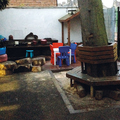 As the one and only tree had begun to lean dangerously, Ms Stevens obtained planning permission to have it felled, leaving the stump intact. Much of the trunk was sliced up to provide dozens of transportable stepping logs, with the rest of it chipped for mulch and surfacing. The removal of the tree allowed the whole space to be reorganised, with a tiny raised sandbox replaced with a much larger, level-access sandpit. This transformed how children played, collaborated and moved – the generous size of the sand area meant that children could collaborate to transport, dig and construct using their whole bodies to achieve their objectives.
As the one and only tree had begun to lean dangerously, Ms Stevens obtained planning permission to have it felled, leaving the stump intact. Much of the trunk was sliced up to provide dozens of transportable stepping logs, with the rest of it chipped for mulch and surfacing. The removal of the tree allowed the whole space to be reorganised, with a tiny raised sandbox replaced with a much larger, level-access sandpit. This transformed how children played, collaborated and moved – the generous size of the sand area meant that children could collaborate to transport, dig and construct using their whole bodies to achieve their objectives.
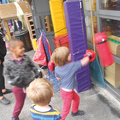 A group of particularly energetic and boisterous boys were thrilled by the arrival of a child-sized boxing bag, suspended underneath the transition canopy. Children’s willingness to take responsibility outdoors was highlighted by the subtle changes to storage solutions: more accessible, more attractive and better locations meant children could easily choose and collect resources, and they (mostly) embraced the end-of-day clearing up.
A group of particularly energetic and boisterous boys were thrilled by the arrival of a child-sized boxing bag, suspended underneath the transition canopy. Children’s willingness to take responsibility outdoors was highlighted by the subtle changes to storage solutions: more accessible, more attractive and better locations meant children could easily choose and collect resources, and they (mostly) embraced the end-of-day clearing up.
As a small, independent pre-school, it had a micro-budget to work with. Once the tree had been felled, Ms Stevens harnessed volunteer labour to create the sandpit and a bigger, more richly resourced mud and messy play area. The area was spruced up with new paint, and items that had been cluttering the tiny garden were moved to the edges to provide free space.
Using their online tracker tool, Little Diamonds discovered:
- a 55 per cent increase in physically active play outdoors
- 62 per cent more use of existing resources
- 42 per cent more activity deemed as ‘involving physicality/bodyfulness’.
Ms Stevens told me, ‘Reflecting on children’s play and asking for their own viewpoints is now recognised as a crucial planning tool for outdoors. Far more opportunities for problem-solving have been observed, with lots of open-ended questions. We saw children engaging in meaningful conversations and relaxed interactions, with practitioners able to judge when to get involved. Children are now learning how to manage risk and finding ways to make their own play more challenging and rewarding.’
ACTION RESEARCH – DIY
Here are some pointers if you want to follow the Newham example and undertake your own action research:
Read all about it
Find out as much as you can about the stages of children’s physical development. This is not the same as physicality, so explore that too, paying particular attention to the sixth and seventh senses: proprioception and the vestibular sense.
Audit provision
Use the auditing tools highlighted in the previous Outdoors and Active articles to establish where gaps in provision for physicality might be. Remember to look at the spaces and resources children are occupying and using, as well as the movements they are making.
Develop a vision for a movement-based curriculum
Discuss a vision for physicality at your setting. It’s important to collaborate as a whole setting, so that the vision (and the strategies you might employ to get there) is shared across all staff. You should also share your thoughts and your vision with parents and carers, providing information about why being physically active every day is important, and how it can be fostered at home.
Agree a focus for your research
What approach will have a positive impact on movement levels? Phrase your question so that it challenges you to test and take action. For example, Avenue Primary School’s action research query was: How can supporting the transporting schema outdoors promote physicality within our setting?
Plan, review and share
Create a detailed action plan, including objectives, timescales, resource implications, issues around risk and allocations of roles and responsibilities.
Build in regular reviews and adapt the project as necessary – incorporating your own tracking tool if you have one. The great thing about action research is that there is no right or wrong answer; simply engaging in the research will tell you much about how to secure positive, lasting change. And share progress with staff, children, parents and carers.
Evaluate
Once your agreed end point has been reached, evaluate progress against the baseline you recorded in the ‘where are we now’ stage. Decide which were the most effective interventions, which offered best value for money, which need more work (or, indeed, abandoning) and which will be the most sustainable. Use this analysis to agree a physicality policy and long-term plan.
Share your success
Share what you have learned with families, other settings and on the Nursery WorldLinkedIn forums or Facebook page, and Twitter via #physicalityoutdoors.
With thanks to the settings, children and parents who participated so enthusiastically; to Jan White and Jasmine Pasch for their expert guidance; to Sally King for chauffeuring me around Newham’s open spaces; and to Tracey Schofield, CPD lead at Newham, for making it all happen.
MORE INFORMATION
Play England’s research into early childhood outdoor activity, www.tinyurl.com/PlayEnglandActive
Coming soon to the Early Education website: the ‘legacy materials’ from Outdoors and Active will be available to download, including the audit tools, case studies and Top Tips, https://www.early-education.org.uk
Every Child A Mover by Jan White (Early Education 2015)
Nursery World Show 2017
Julie Mountain will be leading a seminar 'Outdoors and Active: Newham's response to combating childhood obesity' at 1030am on 3 February at the Nursery World Show 2017, www.nurseryworldshow.com/london









